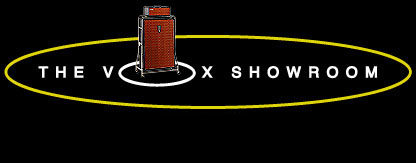
2_Footer
|
© 1996 - 2024 The Vox Showroom, all rights reserved. No use on online auctions, eBay or Reverb.
|
The Vox V414/V4141 Super Beatle and Beatle speaker cabinets and trolleys were the American Vox "spin" of the UK made JMI Vox AC-100 cabinets and trolleys.
In 1964, the Beatles needed increasingly louder amps to cut through the noise level of their screaming audiences. To attack this problem, Tom Jennings and Dick Denney at JMI Vox in the UK first developed the AC-50 (50 watt) amp head using two EL34 power tubes. A matching speaker cabinet was developed for this new head. This cabinet had two Vox/Celestion Alnico Blue 12" speakers and one Goodmans Midax horn. The addition of a Midax horn to the 12 inch speakers was to compensate for the lower treble response of the new AC-50 heads when compared to the AC-30s the Beatles had previously used. Vox enthusiasts refer to this enclosure as the AC-50 "small box" speaker cabinet.
By mid 1964, the new AC-50 amps proved that even they were no match for the screaming girls in the Beatles audiences. Vox in the UK doubled the number of EL34 power tubes used in the AC-50 from two to four, and by doing so, developed the 100 watt AC-100 amplifier head.
To accommodate this additional output power, Vox doubled the former "small box" AC50 speaker cabinet. It now was roughly twice as tall and had four Vox Celestion Alnico Blue 12 inch speakers and two Goodmans Midax horns. A chrome plated steel tubular swivel stand was also developed. This became the AC-100 speaker cabinet.
The AC-100 speaker cabinet was built with 3/4" 13 ply baltic birch plywood, doubtlessly the finest material avaiable for speaker construction. The removable baffle (speaker) board was fastened to the cabinet with fourteen bolts and three screws. The AC-100 was not only impressive by its output, it was impressive by its looks, quality of materials, and workmanship.
Thomas (US) Vox knew that JMI (UK) Vox would never be able to supply enough amps for export to the American market. The Super Beatle was developed by Thomas to be the US replacement for the JMI AC-100. Thomas Organ imported very few AC-100 amps to America.
The first version of the Super Beatle cabinet was the V414 model which had fir plywood sides with particle board baffles and backs. This use of plywood didn't last long, though, as by 1967, the V4141 model replaced the V414. The V4141 was made of particle board. The only plywood used in a Super Beatle cabinet was in the divider betwen the backs.
Thomas Vox used a time stamp on this center divider to record the date of production. A picture at left shows a July 1967 date stamp on a particle board enclosure.
Thomas Organ offered an open backed version of the V4141 as an extra cost option. The standard, closed back version had back panels made from 1" sandwich of two pieces of 1/2" particle board. The only acoustic insulation in the cabinet was on the back. See picture at left.
The baffle, or front panel of the Super Beatle and Beatle speaker cabinet was non removable. Both JMI Vox and Fender stapled their grill fabric onto a removable speaker baffle panel which was bolted into place after grill installation. However, Thomas "face glued" their grill cloth to their cabinets. This made customer replacement of the grill nearly impossible.
The chrome plated tubular steel stand for the Super Beatle speaker cabinet was manufactured in the 1960s by Technibilt, a Los Angeles area shopping cart manufacturer.
Three different versions of the Vox Celestion Alnico Blue speaker may be found in the V4141 enclosure. The earliest, and most valuable version of this speaker is painted in a metalic gray and has wiring lugs located in spokes of the speaker frame. The next version was similar to the first, but had the wiring lugs mounted to a tag strip riveted to the frame. The inside photo of the Beatle pictured on this page has this style speaker. The later versions of the Vox Alnico Blue were painted silver, and also had a riveted wire lug tag strip.
In 1968, Thomas Organ offered an optional upgrade that replaced the silver Celestions with four JBL four D120F 12" speakers. This model was known as the 4141J. An optional upgrade to four 417A Altec Lansing 12" speakers was also offered. This Altec eqipped model was the V4141A. These options may be viewed in the 1968 Vox Product Price List on the Reference Web Page of the Vox Showroom.
The V414/V4141 cabs had two Midax horns. Each Goodmans Midax horn had a 4 uf, 150 volt Aerovox oil filled crossover capacitor with about a 2,000 hz filter to the horn. The capacitor was wired in series to the negative wire going to the horn.
All the speakers and horns were wired in parallel making a 2 ohm total load for the Beatle cabinet. Only a few guitar amplifiers can accommodate this low of a cabinet impedance. Connecting any tube (valve) JMI Vox amplifier to a two ohm cabinet will bring disastrous results to the amp head.
|

